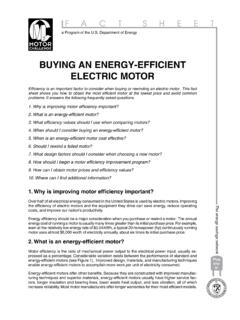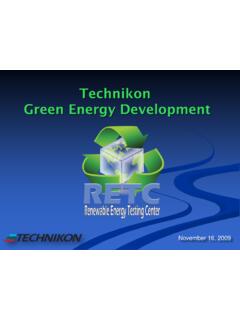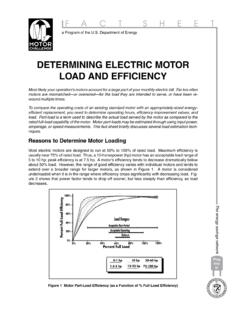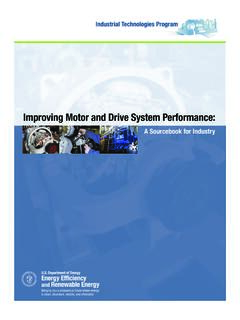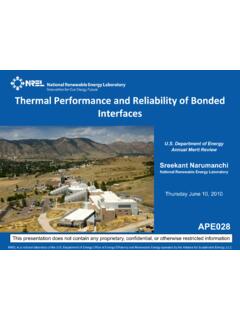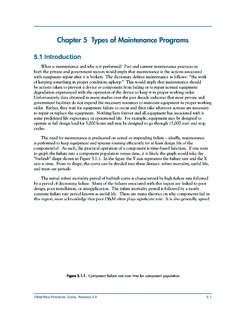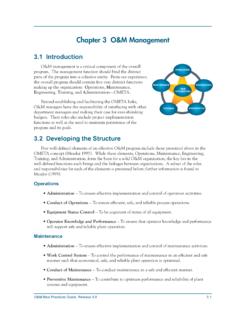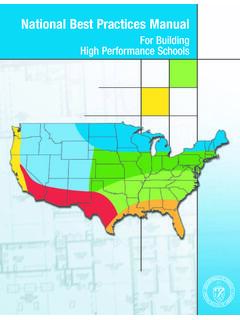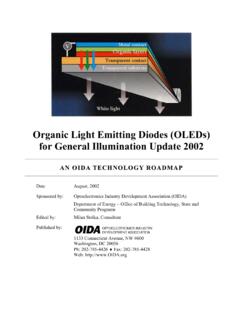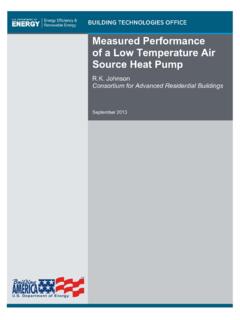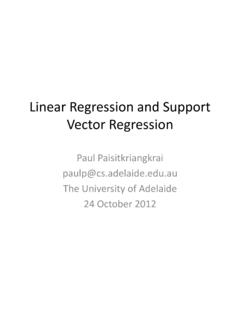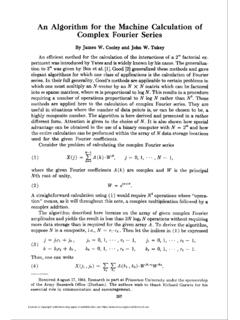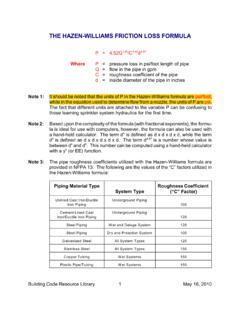Transcription of Waste Heat Recovery - Energy
1 Intentionally Blank Page ii . Waste heat Recovery : . Technology and Opportunities in Industry . Prepared by BCS, Incorporated March 2008. iii . Disclaimer This report was prepared as an account of work sponsored by an Agency of the United States Government. Neither the United States Government nor any Agency thereof, nor any of their employees, makes any warranty, expressed or implied, or assumes any legal liability or responsibility for the accuracy, completeness, or usefulness of any information, apparatus, product, or process disclosed, or represents that its use would not infringe privately owned rights. Reference herein to any specific commercial product, process, or service by trade name, trademark, manufacturer, or otherwise does not necessarily constitute or imply its endorsement, recommendation, or favoring by the United States Government or any Agency thereof.
2 The views and opinions expressed by the authors herein do not necessarily state or reflect those of the United States Government or any Agency thereof. iv . Abstract . The industrial sector accounts for about one third of the total Energy consumed in the United States and is responsible for about one third of fossil fuel related greenhouse gas emissions. It is estimated that somewhere between 20 to 50% of industrial Energy input is lost as Waste heat in the form of hot exhaust gases, cooling water, and heat lost from hot equipment surfaces and heated products. As the industrial sector continues efforts to improve its Energy efficiency, recovering Waste heat losses provides an attractive opportunity for an emission free and less costly Energy resource.
3 Numerous technologies and variations/combinations of technologies are commercially available for Waste heat Recovery . Many industrial facilities have upgraded or are improving their Energy productivity by installing these technologies. However, heat Recovery is not economical or even possible in many cases. This study was initiated in order to evaluate RD&D needs for improving Waste heat Recovery technologies. A bottom up approach is used to evaluate Waste heat quantity, quality, Recovery practices, and technology barriers in some of the largest Energy consuming units in manufacturing. The results from this investigation serve as a basis for understanding the state of Waste heat Recovery and providing recommendations for RD&D to advance Waste heat Recovery technologies.
4 Technology needs are identified in two broad areas: 1) extending the range of existing technologies to enhance their economic feasibility and Recovery efficiency, and 2) exploring new methods for Waste heat Recovery , especially for unconventional Waste heat sources. Acknowledgement We gratefully acknowledge the support of the Department of Energy 's Office of Energy Efficiency and Renewable Energy , Industrial Technologies Program (ITP). This work was carried out by BCS, Incorporated under contract with DOE. The final report presents information from many resources. The research and content was developed by Ilona Johnson and William T. Choate, Amber Davidson provided edits, and Borys Marizza provided the cover design.
5 The authors would like to thank: Elwin L. Rooy, Rooy and Associates (aluminum): H. Wayne Hayden, President, MMPact Incorporated (aluminum);. Michael Greenman, Executive Director, Glass Manufacturing Industrial Council (glass); Fred Rorick, President, Rorick Inc. (steel); and, William A. Obenchain, AISI Technical Manager (steel) for their time and input to our understanding of the industrial processes. v . TABLE of CONTENTS. Index of viii Index of ix Executive Summary .. x 1. What is Waste heat Recovery ? .. 1 . Need for This 3 . Structure of This 4 . Factors Affecting Waste heat Recovery Feasibility .. 6. heat 6 . Waste heat 6 . heat Exchanger Area Requirements.
6 7 . Maximum Efficiency for Power Generation: Carnot Efficiency ..9 . Temperature and Material Selection ..10 . Waste Stream Composition .. 10 . Minimum Allowable Temperature .. 11 . Economies of Scale, Accessibility, and Other 11 . Waste heat Recovery Options and Technologies .. 12. heat 12 .. Passive Air Preheaters ..15 . Regenerative/Recuperative . Finned Tube heat Exchangers/Economizers ..16 . Waste heat Boilers ..17 . Load 17 . Low Temperature Energy Recovery Options and Technologies .. 18 . Challenges to Recovering Low Temperature Waste heat ..19 . Low Temperature heat Exchange ..19 . Power 25 . Generating Power via Mechanical Work ..25 . Direct Electrical Conversion Devices.
7 27 . Summary of heat Recovery 29 . Evaluating Selected Applications for Waste heat Opportunities and Practices .. 33. Glass 34 . Cement 35 . Iron and Steel Manufacturing .. 36 . Integrated Steel . Electric Arc . Waste heat from Solid . vi . Aluminum 43 . Primary Aluminum . Secondary Aluminum . Metal Casting .. 45 . Aluminum . Iron Casting ..47 . Industrial Boilers .. 47 . Ethylene Furnaces .. 49 . Industrial Waste heat Losses and Research Development, and Demonstration Needs 51. Estimates of Exhaust Gas Waste heat Losses from Selected Processes .. 51 . Waste heat Recovery Opportunity 54 . Waste heat 54 . RD&D Needs for Low Temperature Waste heat . Optimization of Systems Already Incorporating Waste heat Recovery .
8 56 . heat Losses from Units Already Including Waste heat Recovery ..56 . RD&D Needs for Optimizing Existing Recovery Systems ..58 . Expanding heat Recovery in Certain Market 58 . Applications Where heat Recovery is Less Common ..58 . Research, Development, and Demonstration Needs for Expanding Implementation of Recovery . Technologies ..60 . Alternate Waste heat 61 . Waste heat Losses from Alternate Sources ..61 . Research, Development, and Demonstration for heat Recovery from Alternate Waste heat Sources61. Summary of Key Barriers to Waste heat 62 . Summary of Research, Development, and Demonstration Opportunities for Waste heat . Recovery .. 63 . 65.
9 END NOTES .. 68. Appendix A Documentation of Waste heat Estimates .. A 1. Appendix B Status of Conventional and Energing Waste heat B 1. vii . Index of Tables Table A Research, Development, and Demonstration Needs for Addressing Waste . heat Recovery Barriers xv . Table 1 Example Waste heat Sources and End Uses 2 . Table 2 Furnace Efficiency Increase with Combustion Air Preheat 3 . Table 3 Estimates of Waste heat loss and Recovery Potential 4 . Table 4 Temperature Classification of Waste heat Sources and Related . Recovery Opportunity 8 . Table 5 General Range Of heat Transfer coefficients for Sensible heat . Transfer in Tubular Exchangers 10 . Table 6 Operating Parameters and Costs for Different heat Pumps 23.
10 Table 7 Options for heat Recovery via Power Generation 25 . Table 8 Comparison of heat Recovery Technologies 30 . Table 9 Status of Waste heat Recovery Technologies in Selected Applications 31 . Table 10 Unrecovered Waste heat and Work Potential from Exhaust . Gases in Glass Melting 35 . Table 11 Unrecovered Waste heat and Work Potential from Exhaust . Gases in Cement Kilns 36 . Table 12 Unrecovered Waste heat and Work Potential from Selected . Process Exhaust Gases in the Iron and Steel Industry 37 . Table 13 Typical Coke Oven Gas Composition 38 . Table 14 Basic Oxygen Furnace Off gas Composition 40 . Table 15 Unrecovered Sensible heat Losses from Hot Solid Streams In.
